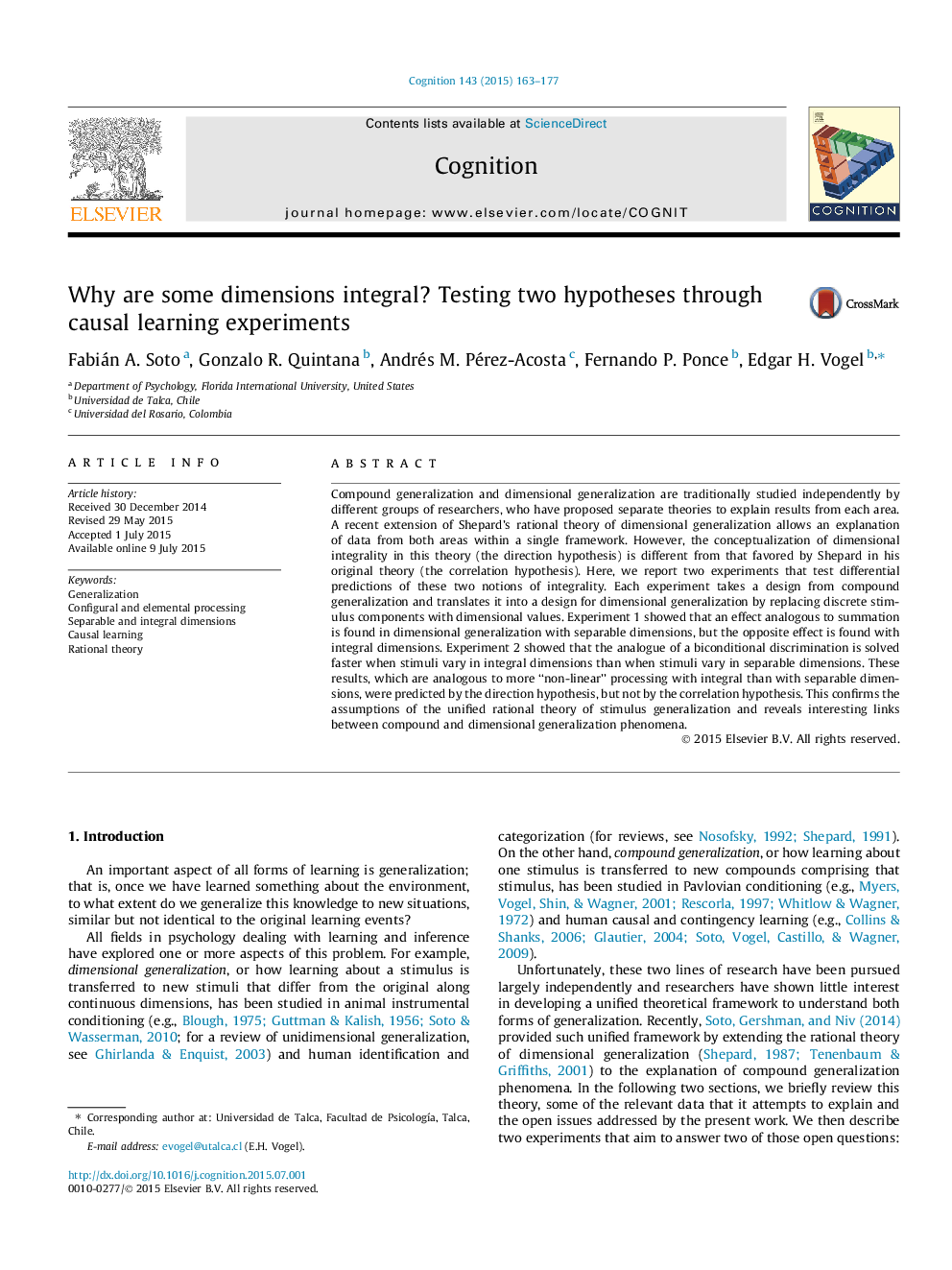| کد مقاله | کد نشریه | سال انتشار | مقاله انگلیسی | نسخه تمام متن |
|---|---|---|---|---|
| 7286721 | 1474124 | 2015 | 15 صفحه PDF | دانلود رایگان |
عنوان انگلیسی مقاله ISI
Why are some dimensions integral? Testing two hypotheses through causal learning experiments
ترجمه فارسی عنوان
چرا برخی مقولات انتگرالی هستند؟ تست دو فرضیه از طریق آزمایشات یادگیری علی
دانلود مقاله + سفارش ترجمه
دانلود مقاله ISI انگلیسی
رایگان برای ایرانیان
کلمات کلیدی
تعمیم، پردازش پیکربندی و عنصری، ابعاد جدا و یکپارچه، یادگیری علمی، تئوری منطقی،
ترجمه چکیده
تعمیم جامع و تعمیم ابعاد به طور سنتی به طور مستقل توسط گروه های مختلف پژوهشگران مورد مطالعه قرار می گیرند، که نظریه های جداگانه ای را برای توضیح نتایج از هر منطقه پیشنهاد می کنند. تمدید اخیر نظریه منطقی شپرد در تعمیم ابعاد، امکان توضیح داده ها را از هر دو حوزه در یک چارچوب واحد فراهم می کند. با این حال، مفهوم سازی یکپارچگی ابعاد در این نظریه (فرضیه مسیر) متفاوت از آن است که مورد نظر شپرد در نظریه اصلی خود (فرضیه همبستگی) مورد نظر است. در اینجا ما دو آزمایش انجام می دهیم که پیش بینی های دیفرانسیل از این دو مفهوم یکپارچگی را تست می کنند. هر آزمایش یک طراحی را از تعمیم ترکیب می گیرد و آن را به جای طراحی مولفه های محرک گسسته با مقادیر ابعادی به یک طراحی برای تعمیم ابعاد می پردازد. آزمایش 1 نشان داد که یک اثر مشابه با جمع شدن در تعمیم ابعاد با ابعاد جدا می شود، اما اثر متقابل با ابعاد انتگرال یافت می شود. آزمودن 2 نشان داد که آنالوگ یک تبعیض دوجانبه سریعتر حل می شود، زمانی که محرک ها در ابعاد یکپارچگی متفاوتند، تا زمانی که محرک ها در ابعاد جداگانه متفاوت باشند. این نتایج، که بیشتر از یک خط غیر خطی مشابه است پردازش با انتگرال نسبت به ابعاد جداگانه، به وسیله فرضیه مسیر پیش بینی شده است، اما نه با فرضیه همبستگی. این فرضیه های تئوری عقلانی متحدانه تعمیم محرک را تایید می کند و ارتباطات جالبی بین پدیده های جمعی و جمعی را نشان می دهد.
موضوعات مرتبط
علوم زیستی و بیوفناوری
علم عصب شناسی
علوم اعصاب شناختی
چکیده انگلیسی
Compound generalization and dimensional generalization are traditionally studied independently by different groups of researchers, who have proposed separate theories to explain results from each area. A recent extension of Shepard's rational theory of dimensional generalization allows an explanation of data from both areas within a single framework. However, the conceptualization of dimensional integrality in this theory (the direction hypothesis) is different from that favored by Shepard in his original theory (the correlation hypothesis). Here, we report two experiments that test differential predictions of these two notions of integrality. Each experiment takes a design from compound generalization and translates it into a design for dimensional generalization by replacing discrete stimulus components with dimensional values. Experiment 1 showed that an effect analogous to summation is found in dimensional generalization with separable dimensions, but the opposite effect is found with integral dimensions. Experiment 2 showed that the analogue of a biconditional discrimination is solved faster when stimuli vary in integral dimensions than when stimuli vary in separable dimensions. These results, which are analogous to more “non-linear” processing with integral than with separable dimensions, were predicted by the direction hypothesis, but not by the correlation hypothesis. This confirms the assumptions of the unified rational theory of stimulus generalization and reveals interesting links between compound and dimensional generalization phenomena.
ناشر
Database: Elsevier - ScienceDirect (ساینس دایرکت)
Journal: Cognition - Volume 143, October 2015, Pages 163-177
Journal: Cognition - Volume 143, October 2015, Pages 163-177
نویسندگان
Fabián A. Soto, Gonzalo R. Quintana, Andrés M. Pérez-Acosta, Fernando P. Ponce, Edgar H. Vogel,
